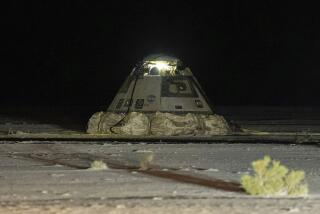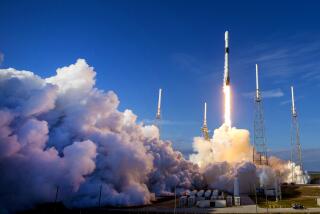Shuttle Launch Safety Tested in Fire, Blast Drill
KENNEDY SPACE CENTER, Fla. — Astronauts and launch pad workers scrambled into escape baskets Wednesday as they fled a mock fire and explosion during a space shuttle disaster drill.
For safety reasons, they did not ride the baskets down long cables, traveling instead by elevator to the ground, then re-entering the baskets to continue the exercise. NASA officials said they will “man-rate” the baskets before the next shuttle flight.
All seven participating astronauts and several other personnel received make-believe injuries in the four-hour pad test. Two of the astronauts were among nine “seriously injured” people transported by helicopter to two hospitals that conducted their own rehearsals.
Shuttle Fleet Grounded
The drill tested new safety procedures initiated since the explosion of Challenger and the loss of its seven crew members on Jan. 28, 1986. The shuttle fleet has been grounded since then, and NASA’s top official, administrator James C. Fletcher, said Tuesday that flights are not expected to resume before late August or September.
“Our expected plan is to fly in August,” Fletcher told the American Institute of Aeronautics and Astronautics. “Whether it slops over into early September I think is not important. We will fly this summer.”
Reporters pressed Fletcher on the date after his speech and he said officials were “looking” at Aug. 25 and into early September.
Among new launch pad features tested Wednesday were improved fire detection equipment, more fire-resistant material, a new steel-reinforced concrete underground bunker and a backup electrical relay line that flashes a warning to launch directors if a pad emergency occurs.
Such an “emergency” took place shortly after the seven astronauts simulated entry into a spacecraft cabin. About that time, a smoke bomb was detonated on the pad, and test director Frank Merlino ordered an evacuation.
Baskets Believed Risky
No one rode the escape baskets down 1,200-foot cables to the ground. Some officials believe the swift 50 m.p.h. trip and abrupt halt in netting at the bottom would be risky and should be attempted only in an actual emergency.
National Aeronautics and Space Administration officials have said they plan soon to test the baskets with human passengers.
Another drill is scheduled Friday to simulate a rescue of crew members from a shuttle that has “crash-landed” in a swamp near the shuttle landing runway.
More to Read
Sign up for Essential California
The most important California stories and recommendations in your inbox every morning.
You may occasionally receive promotional content from the Los Angeles Times.










